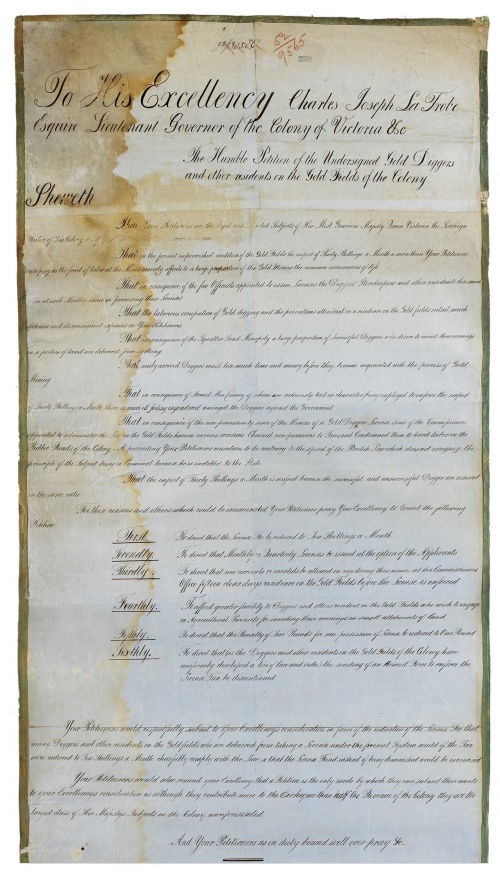Difference between revisions of "John Semmens"
| Line 6: | Line 6: | ||
==Goldfields Involvement, 1854== | ==Goldfields Involvement, 1854== | ||
| − | John Semmens signed the 1853 Bendigo Goldfields Petition, the result of a political movement known as the Red Ribbon Rebellion, where agitators wore red ribbons on their hats symbolising defiance of the law and the prohibitive licence fees imposed on all gold seekers. The goldfields agitation started with the [[Forest Creek]] Monster Meeting in 1851, but the Red Ribbon movement was centred around the [[Bendigo]] goldfields. It was led by GE Thomson, Dr Jones and 'Captain' [[Edward Brown]], the association focused its attention on the 30 shillings monthly licence fee miners were required to pay to the government. The drew up y devised a petition outlining the diggers' grievances and calling for a reduced licence fee, improved law and order, the right to vote and the right to buy land. The petition was signed by diggers at [[Bendigo]], [[Ballarat]], [[Castlemaine]], [[McIvor]] ([[Heathcote]]), [[Mount Alexander]] ([[Harcourt]]) and other diggings. The petition was brought to Melbourne and presented to Lieutenant-Governor Charles [[Joseph | + | John Semmens signed the 1853 Bendigo Goldfields Petition, the result of a political movement known as the Red Ribbon Rebellion, where agitators wore red ribbons on their hats symbolising defiance of the law and the prohibitive licence fees imposed on all gold seekers. The goldfields agitation started with the [[Forest Creek]] Monster Meeting in 1851, but the Red Ribbon movement was centred around the [[Bendigo]] goldfields. It was led by GE Thomson, Dr Jones and 'Captain' [[Edward Brown]], the association focused its attention on the 30 shillings monthly licence fee miners were required to pay to the government. The drew up y devised a petition outlining the diggers' grievances and calling for a reduced licence fee, improved law and order, the right to vote and the right to buy land. The petition was signed by diggers at [[Bendigo]], [[Ballarat]], [[Castlemaine]], [[McIvor]] ([[Heathcote]]), [[Mount Alexander]] ([[Harcourt]]) and other diggings. The petition was brought to Melbourne and presented to Lieutenant-Governor Charles [[Joseph LaTrobe]] on the 01 August 1853. |
Agitators wore red ribbons on their hats symbolising defiance of the law and the prohibitive licence fees imposed on lucky and unlucky miners alike. | Agitators wore red ribbons on their hats symbolising defiance of the law and the prohibitive licence fees imposed on lucky and unlucky miners alike. | ||
Revision as of 11:00, 23 February 2019
Contents
Background
Goldfields Involvement, 1854
John Semmens signed the 1853 Bendigo Goldfields Petition, the result of a political movement known as the Red Ribbon Rebellion, where agitators wore red ribbons on their hats symbolising defiance of the law and the prohibitive licence fees imposed on all gold seekers. The goldfields agitation started with the Forest Creek Monster Meeting in 1851, but the Red Ribbon movement was centred around the Bendigo goldfields. It was led by GE Thomson, Dr Jones and 'Captain' Edward Brown, the association focused its attention on the 30 shillings monthly licence fee miners were required to pay to the government. The drew up y devised a petition outlining the diggers' grievances and calling for a reduced licence fee, improved law and order, the right to vote and the right to buy land. The petition was signed by diggers at Bendigo, Ballarat, Castlemaine, McIvor (Heathcote), Mount Alexander (Harcourt) and other diggings. The petition was brought to Melbourne and presented to Lieutenant-Governor Charles Joseph LaTrobe on the 01 August 1853.
Agitators wore red ribbons on their hats symbolising defiance of the law and the prohibitive licence fees imposed on lucky and unlucky miners alike.
They organised the Bendigo Petition in mid-1853, and by the time it was sent to Melbourne it was 13 metres in length. The petition called for a reduction in monthly licence fees and land reform for diggers.
By mid-1853 around 60,000 diggers and their families were on the Victorian goldfields - nearly 23,000 of these were at Bendigo. In June 1853 an anti-gold licence association was formed at Bendigo to give voice to the diggers' many grievances about their conditions. Led by GE Thomson, Dr Jones and an Irish-born American, 'Captain' Edward Brown, the association focused its attention on the 30 shillings monthly licence fee miners were required to pay to the government. Drawing up the petition. These three men drew up a petition outlining the diggers' grievances and calling for a reduced licence fee, improved law and order, the right to vote and the right to buy land. The petition was signed by diggers at Bendigo, Ballarat, Castlemaine, McIvor (Heathcote), Mount Alexander (Harcourt) and other diggings. The petition was brought to Melbourne and presented to Lieutenant-Governor Charles Joseph La Trobe on the 1 August 1853. Most of its demands, including the reduction in the licence fee, were rejected. Eventually the diggers' dissatisfaction erupted, culminating in the Eureka uprising at Ballarat on 3 December 1854.
Post 1854 Experiences
See also
Further Reading
References
External links
To CITE this page click on the link to the left.
